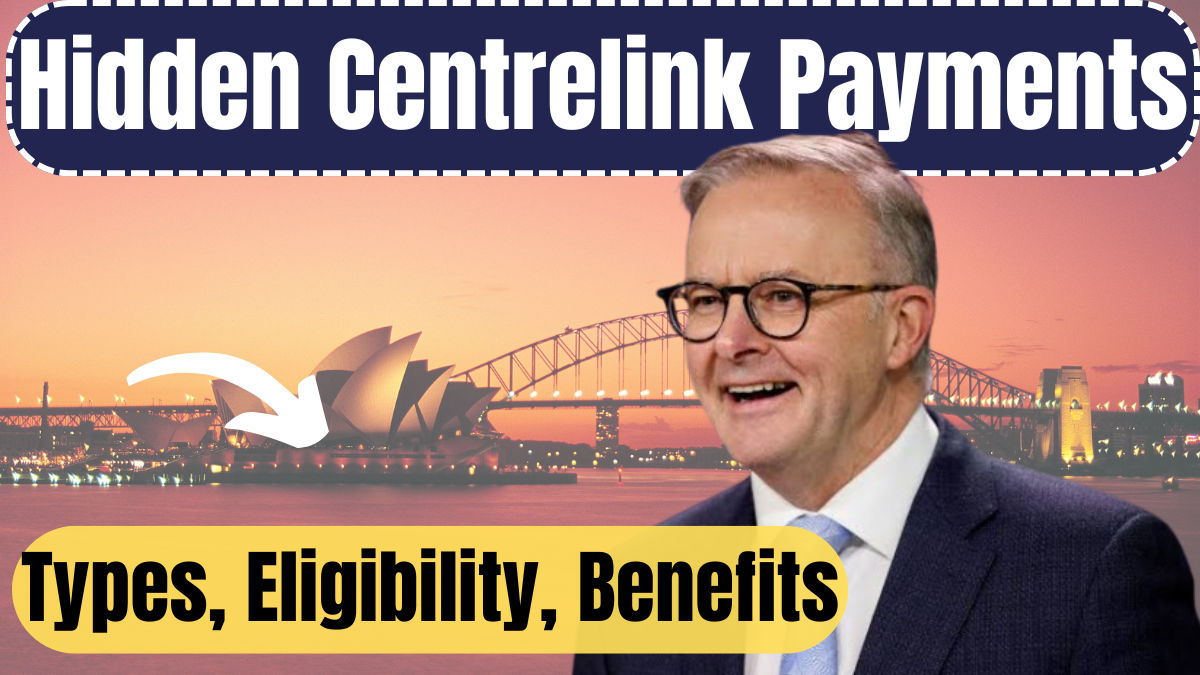Hidden Centrelink Payments refer to lesser-publicized financial support options provided by the Australian government under its Centrelink program. While most people are aware of primary benefits like JobSeeker, Age Pension, or Parenting Payment, many are unaware of additional crisis payments and supplements that can help during emergencies, domestic violence, or critical life changes.
These payments are not always widely advertised, which is why many eligible Australians miss out on support they’re entitled to. From assisting refugees to helping those facing medical or financial emergencies, these payments are essential for restoring stability and providing a safety net.

Types of Hidden Centrelink Payments 2025
| Payment Type | Purpose |
|---|---|
| Humanitarian Entrant Payments | Helps new arrivals and refugees settle in Australia. |
| Crisis Payment | One-time payment for those escaping crises like domestic violence or disasters. |
| Energy Supplement | Regular payment to assist with rising energy costs for eligible recipients. |
| Pharmaceutical Allowance | Covers the cost of prescription medications for pension recipients. |
| Parenting Payment | Income-tested support for low-income parents. |
| Domestic Violence Support Payment | Special crisis payment for victims escaping abusive environments. |
These hidden payments can be one-time deposits or ongoing quarterly payments, depending on the recipient’s situation. They offer relief for essential costs such as food, medication, housing, or caregiving expenses.
Eligibility for Hidden Centrelink Payments in 2025
Eligibility depends on personal circumstances, including age, income, residency, and crisis situation. You may qualify if you meet the following conditions:
- You are a lawful Australian resident or citizen.
- You are at least 16 years old for Youth Allowance-related payments.
- You have a documented disability if applying for the Disability Support Pension.
- You’re currently receiving a primary Centrelink payment, such as JobSeeker, Age Pension, or Carer Payment.
- You can provide valid documents such as income proof, birth certificates, medical records, or housing details.
In some cases, you may automatically receive these hidden benefits with your existing Centrelink payment. For others, you must apply separately through your myGov account or by visiting a Centrelink service centre.
How Hidden Centrelink Payments Help Australians
Hidden Centrelink Payments aren’t just financial support—they also contribute to mental and emotional well-being, particularly during tough times. They can:
- Provide a fresh start for victims of domestic violence by helping them relocate safely.
- Offer essential resources for those affected by natural disasters like floods or bushfires.
- Help refugees or humanitarian entrants integrate smoothly into a new culture.
- Support those leaving correctional facilities or rehabilitation centres in rebuilding their lives.
- Assist with medical-related expenses and ensure access to essential medication.
- Offer a financial cushion during unexpected life transitions, like job loss or illness.
These benefits serve not just as temporary help but as a bridge to long-term stability and self-sufficiency.
Key Details About Centrelink Hidden Benefits 2025
| Aspect | Details |
|---|---|
| Program Authority | Centrelink, Australia |
| Target Beneficiaries | Australians in crisis or major life transitions |
| Payment Frequency | One-time or quarterly payments depending on type |
| Eligibility Requirements | Residency status, age, financial/emergency need, and required documentation |
| Application Method | Online via myGov or in-person through Centrelink |
Whether you’re dealing with an emergency or facing long-term hardship, these payments can provide meaningful financial relief and access to essential services.
When Will Hidden Centrelink Payments Be Made in 2025?
While the exact payment dates for 2025 have not yet been released, beneficiaries can expect payments to align with individual circumstances and approval timelines. For crisis situations, payments are typically made within days of approval, while supplements like the Energy Payment may be distributed quarterly.
To stay informed:
- Visit the official Services Australia website
- Log in to your myGov account regularly
- Contact Centrelink directly for any assistance regarding pending or possible payments
Being proactive and aware of these lesser-known benefits is the key to ensuring you receive the support you deserve.
FAQs
What makes these Centrelink payments “hidden”?
They are referred to as “hidden” because they are not as widely advertised or known as mainstream payments like JobSeeker or Age Pension.
Can I receive multiple hidden payments at once?
Yes, if you meet eligibility for more than one type—such as Crisis Payment and Energy Supplement—you can receive them concurrently.
Do I need to repay any hidden Centrelink payments?
No. These are non-repayable government supports designed to assist during difficult periods.
Are these payments taxable?
Most hidden payments, like the Crisis Payment and Pharmaceutical Allowance, are non-taxable.
How can I check if I qualify?
Log into your myGov account, explore Centrelink’s available benefits, or consult with a representative for personalized advice.
What documentation is usually required?
Typical documents include proof of residency, medical records, income verification, and crisis evidence (such as a police report or eviction notice).
Is there a deadline to apply for crisis payments?
Yes, applications for Crisis Payments must usually be made within 7 days of the qualifying event.
Can I receive payments if I’m already on another Centrelink benefit?
Absolutely. Hidden Centrelink Payments are often add-ons or supplements to existing benefits.
Click here to know more.
Aanchal is a passionate writer with a keen interest in storytelling, content creation, and creative expression. She enjoys exploring diverse topics and crafting engaging narratives that captivate readers.